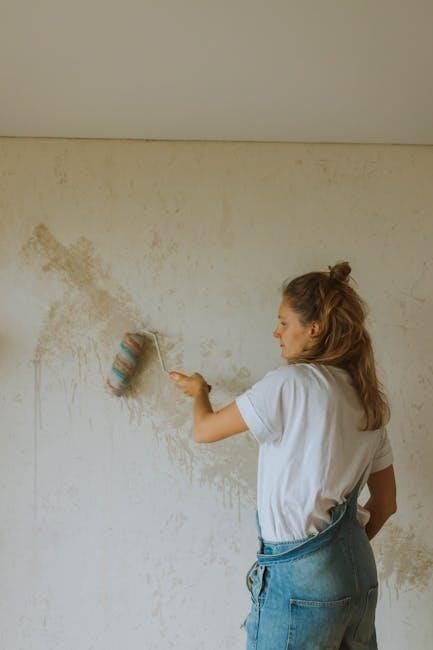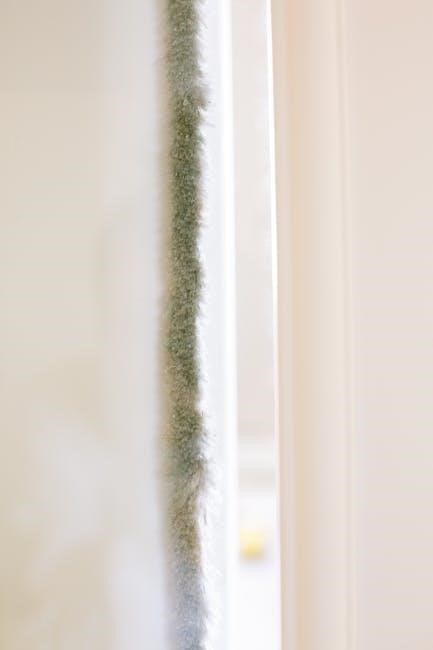Transform your home sustainably with eco renovation, a journey to reduce your carbon footprint and enhance your living space while promoting cost savings and a healthier environment․
What is Eco Renovation?
Eco renovation is the process of transforming existing spaces to enhance sustainability, energy efficiency, and environmental harmony․ It involves using eco-friendly materials, reducing waste, and implementing energy-saving technologies to create a greener, healthier living environment while minimizing the home’s carbon footprint and promoting long-term cost savings․
Why Eco Renovation Matters
Eco renovation is crucial for reducing your carbon footprint, enhancing energy efficiency, and lowering costs․ It promotes a healthier living environment and helps preserve natural resources, making it a vital step toward sustainability and a greener future․
Benefits of Eco Renovation
Eco renovation offers numerous benefits, including reduced energy costs, enhanced indoor air quality, and increased property value․ It fosters a healthier living space while contributing to environmental sustainability and future-proofing your home with modern, eco-friendly solutions․
Assessing Your Green Goals
Assessing your green goals is the first step in eco renovation, helping you identify priorities and create a plan that aligns with your values and targets a sustainable future․
Understanding Your Objectives
Understanding your objectives is crucial for a successful eco renovation․ Identify whether your goal is to reduce energy consumption, lower costs, or promote sustainability․ Clarify if you aim to enhance indoor air quality, conserve water, or incorporate renewable energy sources․ Aligning your renovation with clear, prioritized objectives ensures a focused approach and helps guide decision-making throughout the process․
Identifying Key Areas for Improvement
Identifying key areas for improvement is essential for an effective eco renovation․ Start by assessing energy-use patterns, water consumption, and material sustainability in your home․ Check for air leaks, outdated appliances, and inefficient systems․ Prioritize areas that offer the most significant environmental and cost-saving benefits, such as insulation, windows, and lighting․ This step ensures your renovation targets the most impactful changes first․
Setting Realistic Targets
Setting realistic targets is crucial for a successful eco renovation․ Start by creating a clear plan aligned with your budget and resources․ Prioritize changes that offer the most impact, such as upgrading to energy-efficient appliances or using sustainable materials․ Break your goals into manageable steps to avoid overwhelm․ Consider government incentives and rebates to help achieve your targets while staying within your means․
Planning Your Eco Renovation
Plan your eco renovation by setting a budget, hiring eco-friendly professionals, and selecting sustainable materials to ensure a smooth transition to a greener, energy-efficient home․
Creating a Budget
Creating a budget for eco renovation involves setting realistic financial targets, prioritizing essential upgrades, and exploring financing options to ensure sustainable choices align with your resources and goals․
Hiring Eco-Friendly Professionals
Hiring eco-friendly professionals ensures your renovation aligns with sustainable practices․ Look for experts with expertise in energy efficiency, sustainable materials, and green building certifications․ They can guide you in making environmentally responsible choices while adhering to your budget and vision, ensuring a smooth and eco-conscious renovation process from start to finish․
Choosing Sustainable Materials
Selecting sustainable materials is crucial for eco-friendly renovations․ Opt for reclaimed wood, recycled metals, and low-VOC paints to minimize environmental impact․ Consider materials like bamboo, cork, and FSC-certified wood for flooring․ These options reduce waste, conserve resources, and promote healthier indoor air quality while enhancing your home’s aesthetic and value, ensuring a greener and more sustainable living space for years to come․
Energy Efficiency in Eco Renovation
Enhance your home’s energy efficiency to reduce consumption and costs while promoting sustainability․ This approach ensures long-term savings and a more comfortable, eco-friendly living environment․
Improving Insulation
Enhancing insulation is a cornerstone of eco renovation, reducing heat loss and energy consumption․ Properly insulating walls, attics, and floors minimizes drafts, lowers utility bills, and creates a more comfortable living space․ Eco-friendly insulation materials like recycled denim or wool offer sustainable solutions while maintaining energy efficiency․ This step is essential for achieving long-term energy savings and reducing your home’s carbon footprint․
Upgrading to Energy-Efficient Appliances
Upgrading to energy-efficient appliances is a key step in eco renovation, reducing energy consumption and lowering utility bills․ Look for appliances with high ENERGY STAR ratings, as they use less energy while maintaining performance․ This switch not only cuts your carbon footprint but also qualifies for government incentives, making it a cost-effective and environmentally responsible choice for your home․
Installing Solar Panels
Installing solar panels is a powerful step in eco renovation, harnessing renewable energy to reduce your reliance on the grid․ This upgrade lowers electricity costs, reduces your carbon footprint, and qualifies for government tax credits and rebates․ Solar panels are a sustainable, long-term investment that enhances energy efficiency while promoting environmental conservation, making them a standout choice for eco-conscious homeowners․
Sustainable Materials for Renovation
Sustainable materials are a cornerstone of eco renovation, offering eco-friendly options like reclaimed wood, recycled metals, and low-VOC paints to reduce environmental impact and enhance home value․
Using Recycled and Reclaimed Materials
Recycled and reclaimed materials are key to eco-friendly renovations, offering cost-effective and sustainable solutions․ Reclaimed wood adds character, while recycled metals and plastics reduce waste․ These materials minimize environmental impact by reusing resources, lowering carbon footprints, and preserving natural habitats․ Incorporating them enhances your home’s uniqueness while contributing to a greener future․
Opting for Low-VOC Paints
Low-VOC (volatile organic compound) paints are a healthier choice for eco-friendly renovations․ They emit fewer harmful fumes, improving indoor air quality and reducing environmental impact․ These paints are free from toxic chemicals, creating a safer living space while aligning with sustainable practices․ Choose low-VOC options to minimize toxins and promote a greener, healthier home environment․
Selecting Eco-Friendly Flooring
Eco-friendly flooring options like bamboo, reclaimed wood, and cork are sustainable choices that minimize environmental impact․ These materials are durable, renewable, and free from harmful chemicals, enhancing indoor air quality․ Bamboo grows quickly, making it a highly renewable resource, while reclaimed wood reduces waste․ Cork is soft, warm, and naturally resistant to pests․ Choose these options for a greener, healthier home․

Water Conservation Tips
Save water with low-flow fixtures, rainwater harvesting systems, and efficient appliances․ Fix leaks promptly to reduce waste and lower utility bills while protecting this vital resource․
Installing Low-Flow Fixtures
Low-flow fixtures are essential for water conservation․ Replace traditional faucets, showerheads, and toilets with low-flow alternatives to significantly reduce water usage․ These fixtures use advanced technology to maintain performance while minimizing water consumption․ Look for products labeled with the WaterSense certification to ensure efficiency․ Installing low-flow fixtures is a simple yet effective way to conserve water and lower utility bills without sacrificing comfort or functionality․
Implementing Rainwater Harvesting
Implementing rainwater harvesting is a practical eco-friendly solution to reduce water consumption․ By collecting and storing rainwater in barrels or tanks, you can use it for irrigation, flushing toilets, or washing machines․ This system lowers water bills and reduces strain on municipal supplies․ Simple filtration systems can ensure water quality, making it a sustainable choice for homeowners aiming to conserve this vital resource effectively․
Choosing Water-Efficient Appliances
Opting for water-efficient appliances is a smart move in eco renovation․ Look for appliances with labels like ENERGY STAR, which meet strict water and energy efficiency standards․ These devices, such as low-flow toilets and eco-friendly washing machines, significantly reduce water consumption and energy use, lowering utility bills while promoting environmental sustainability․ They are cost-effective and environmentally responsible choices for modern homes․

Indoor Air Quality
Improving indoor air quality enhances health and comfort․ Use natural materials, non-toxic paints, and proper ventilation to reduce exposure to harmful pollutants and create a cleaner environment․
Reducing Toxins in Your Home
Minimize harmful substances by using non-toxic paints, natural materials, and eco-friendly cleaning products․ Incorporate air-purifying plants and improve ventilation to eliminate pollutants, creating a safer and healthier living environment․
Using Natural and Non-Toxic Materials
Opt for sustainable materials like reclaimed wood, bamboo, and natural fibers to reduce chemical exposure․ Choose low-VOC paints and adhesives to enhance indoor air quality and promote a healthier home environment․ These eco-friendly options minimize toxins and support long-term well-being for your family․
Improving Ventilation Systems
Enhance indoor air quality by installing energy-efficient ventilation systems like heat recovery ventilators․ Ensure proper air circulation to reduce moisture and pollutants, creating a healthier living environment․ Regular maintenance and upgrades can significantly improve air flow, contributing to better health and energy efficiency in your eco-friendly home․

Outdoor Eco-Friendly Features
Enhance your home’s exterior with eco-friendly features like green roofs, sustainable landscaping, and permeable pavers․ These elements improve biodiversity, manage stormwater, and reduce environmental impact effectively․
Creating a Green Roof
A green roof is a sustainable outdoor feature that combines plants and a growing medium over a waterproof layer․ It improves air quality, reduces urban heat islands, and provides insulation․ Choose low-maintenance plants like sedums or native species․ Ensure proper drainage and structural support․ Regular watering and fertilization are essential․ Green roofs also help manage stormwater and enhance biodiversity, making them a stylish, eco-friendly choice for homeowners․
Designing Sustainable Landscaping
Sustainable landscaping reduces water use and enhances ecosystems․ Use drought-resistant plants and native species to minimize maintenance․ Incorporate low-flow irrigation systems and rainwater harvesting․ Add permeable pavers to manage stormwater․ Use eco-friendly outdoor lighting like solar-powered lights․ Recycle yard waste into compost․ Design with biodiversity in mind to attract pollinators․ These practices create a beautiful, eco-friendly outdoor space while supporting the environment and reducing resource consumption․
Installing Permeable Pavers
Permeable pavers are an excellent eco-friendly solution for outdoor spaces․ They allow rainwater to infiltrate the ground, reducing stormwater runoff and filtering pollutants․ Made from materials like porous concrete or permeable asphalt, they promote water conservation and reduce erosion․ Their durability and low maintenance make them ideal for driveways, walkways, and patios, enhancing sustainability while maintaining aesthetic appeal and functionality․

Government Incentives and Grants
Governments offer incentives like tax credits and rebates to encourage eco-friendly renovations․ These programs help reduce initial costs and promote sustainable practices, making green upgrades more accessible for homeowners․
Exploring Tax Credits
Tax credits provide financial relief for eco-friendly renovations․ Many governments offer credits for energy-efficient upgrades like solar panels and insulation․ These incentives reduce initial costs, encouraging sustainable improvements․ Check local and national programs to see if your eco-renovation qualifies․ Credits vary by location, but they often cover a portion of expenses․ Research eligibility and application processes to maximize savings․
Applying for Green Grants
Green grants are funds provided to support eco-friendly home renovations․ These grants aim to promote sustainability by covering costs for energy-efficient upgrades, renewable energy installations, and sustainable materials․ Eligibility varies, but many programs target homeowners aiming to reduce environmental impact․ Research local, state, and national grant opportunities to find suitable options for your eco-renovation project․ Applying may require detailed project plans and proof of eco-friendly practices․
Understanding Rebates
Rebates are financial incentives offered to homeowners for adopting eco-friendly practices․ They help reduce the upfront costs of energy-efficient upgrades, such as solar panels or insulation․ Rebates are often provided by governments or utility companies to encourage sustainable renovations․ Check local programs and eligibility criteria to maximize savings on your eco-renovation projects․
Maintenance and Long-Term Benefits
Regular upkeep ensures eco-friendly upgrades remain efficient, while long-term benefits include reduced energy costs, a healthier living environment, and increased property value over time․
Regular Maintenance Practices
Regular maintenance is crucial for sustaining eco-friendly renovations․ Inspect solar panels, HVAC systems, and insulation annually․ Check for air leaks, clean energy-efficient appliances, and monitor water systems․ Replace filters regularly and use eco-friendly cleaning products․ Schedule professional check-ups for complex systems to ensure optimal performance and longevity․ Consistent upkeep ensures long-term energy savings and environmental benefits, while maintaining a healthy, efficient home environment․
Monitoring Energy Efficiency
Track your home’s energy usage with smart meters and regular audits to ensure eco-friendly renovations are performing effectively․ Monitor solar panel output and appliance efficiency to identify areas for improvement․ This proactive approach helps maintain energy savings, reduces waste, and supports long-term environmental goals while optimizing your home’s performance and sustainability․
Enjoying Long-Term Cost Savings
Eco-friendly renovations often lead to significant long-term cost savings through reduced energy and water bills․ Sustainable materials and energy-efficient systems lower utility expenses while increasing your home’s value․ Government incentives and tax credits further enhance financial benefits, making eco renovation a smart investment for both the environment and your wallet․



0 Comments